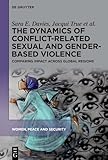The Dynamics of Conflict-Related Sexual and Gender-Based Violence : Comparing Impact Across Global Regions / Sara E. Davies, Jacqui True, Yolanda Riveros Morales, Rachel Banfield, Phyu Phyu Oo, Joana Osei-Tutu.
Material type: TextSeries: Women, Peace and Security ; 1Publisher: Berlin ; Boston : De Gruyter, [2024]Copyright date: 2024Description: 1 online resource (X, 185 p.)Content type:
TextSeries: Women, Peace and Security ; 1Publisher: Berlin ; Boston : De Gruyter, [2024]Copyright date: 2024Description: 1 online resource (X, 185 p.)Content type: - 9783111320632
- 9783111321080
- 9783111320861
- Gender-based violence
- Sex crimes
- Sexual abuse victims
- Women -- Violence against
- Gewalt gegen Frauen
- Konfliktforschung
- Kriegsverbrechen
- Menschenrechte
- sexuelle Gewalt
- Frau
- Geschlecht
- Gewalt
- Kriegsverbrechen
- Sexualverhalten
- Fallstudie
- Bewaffneter Konflikt
- Menschenrechtsverletzung
- SOCIAL SCIENCE / Women's Studies
- Conflict
- Gendered Violence
- Human Rights
- Sexual Violence
- War Crimes
- 320
- online - DeGruyter
- Issued also in print.
| Item type | Current library | Call number | URL | Status | Notes | Barcode | |
|---|---|---|---|---|---|---|---|
 eBook
eBook
|
Biblioteca "Angelicum" Pont. Univ. S.Tommaso d'Aquino Nuvola online | online - DeGruyter (Browse shelf(Opens below)) | Online access | Not for loan (Accesso limitato) | Accesso per gli utenti autorizzati / Access for authorized users | (dgr)9783111320861 |
Frontmatter -- Acknowledgments -- Contents -- List of Abbreviations -- List of Figures -- List of Tables -- Chapter One Intensity and Dynamics of Conflict-Related Sexual and Gender-Based Violence (SGBV) -- Chapter Two Seven Hypotheses for Seven Conflicts— Detecting Conflict-Related Sexual and Gender-Based Violence -- Chapter Three Conflict-Related Sexual and Gender-Based Violence during Non-State and State-Led Violence in Syria, 2013–2015 -- Chapter Four Conflict-Related Sexual and Gender-Based Violence and Non-State Led Violence in the Central African Republic, 2012–2014 -- Chapter Five Conflict-Related Sexual and Gender-Based Violence and the Dynamics of Fragility in South Sudan, 2013–2015 -- Chapter Six State-Led Conflict-Related Sexual and Gender- Based Violence and Mass Atrocities in Myanmar, 2016–2018 -- Chapter Seven Reporting Conflict-Related Sexual and Gender-Based Violence during Low-Intensity Civil Conflict in the Philippines, 2016–2018 -- Chapter Eight Terrorism-Related Sexual and Gender-Based Violence in North-Eastern Nigeria, 2013–2015 -- Chapter Nine Conflict-Related Sexual and Gender-Based Violence in Colombia Before the Peace Process, 2010–2012 -- Chapter Ten Understanding the Onset and Intensity of Conflict-Related Sexual and Gender-Based Violence -- Appendix A -- References -- Index
restricted access online access with authorization star
http://purl.org/coar/access_right/c_16ec
Due to the international importance attached to the reporting of conflict-related sexual and gender-based violence (SGBV) over the last two decades, scholars have been able to examine the magnitude of the problem across different situations and types of conflict. But what changes to intensity and type of violence occur during different phrases of conflict intensity? Is reporting consistent across different conflicts and different regional experiences of conflict-related SGBV? This book examines different conflict situations in Africa, Latin America, the Middle East, and Asia over the past decade, 2010–2020. The chapters in the book use a mixed-method approach to explore the patterns of violence in situations of one-sided violence, state-led violence, non-state-led violence, low intensity violence, terrorism and fragility. They investigate the trajectory of international and prevention efforts, and the development of country-level responses to reports of sexual and gender-based violence in these various conflict situations. The book explains how and why these responses were mobilised in response to reports and considers the conditions for effective reporting in real time considering the patterns and the structural root causes of the violence.
Issued also in print.
Mode of access: Internet via World Wide Web.
In English.
Description based on online resource; title from PDF title page (publisher's Web site, viewed 20. Nov 2024)


